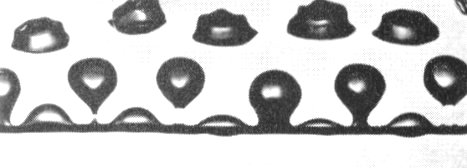Surface Tension
Today, we look at the edge of a water droplet. The University of Houston's College of Engineering presents this series about the machines that make our civilization run, and the people whose ingenuity created them.
Imagine releasing water in the space station and letting it float before you. It forms a spherical liquid drop. The sphere is tremulous. Touch it and it vibrates. Waves ripple around it.
It's as though the liquid were held in a gossamer rubber bag, for a skin forms outside the liquid. That skin is called a surface layer, it's made of pure water, and it exerts a tension. The water surface pulls upon itself with the same intensity everywhere, regardless of the size of the sphere. There's no retreating from the force. Make the sphere smaller and the surface pulls just as hard.
The surface layer is formed by strange balancing act. If you could make yourself as small as a molecule and get inside the layer, it would look like a vast region of change -- maybe a hundred molecules thick. The liquid molecules at the bottom would form a closely packed thicket. They'd thin out as you rose through the layer and be far apart where they formed a gas, above.
Each molecule pulls on all the others, most strongly on the ones nearest. They take up a precise vertical and horizontal spacing in the layer that lets each be in perfect balance with all the others. After they've spaced themselves out, they leave large net forces acting along the layer, on either side of the molecule.
It takes energy to create that surface layer. Just as a spring stores energy, so too does the surface of a drop. Suppose I inserted a water-filled hypodermic needle into that liquid sphere on the space station. I'd have to press the water into it if I wanted it to be larger. I'd be adding the energy needed to increase the surface. Or the sphere might drive water into the hypodermic, powered by the energy that the shrinking surface gives up.
So much human ingenuity has been invested in the problem of making water into small droplets. Next time you use a pump atomizer, notice how you have to work to break liquid into a spray. It takes an effort to create all those new surfaces.
The more I study water surfaces, so deceptively simple, the deeper I'm led into surprise and the beauty of nature at its most elementary level. Try an experiment: Find a long wide tube, maybe three feet long. Glue aluminum foil across the bottom, with a clean eighth-of-an-inch hole in the center. Fill the tube with water, and let it drain onto the wide flat head of a roofing nail.
The liquid will flow off the nail head in a sheet that thins until it's only thousandths of an inch thick. Watch how surface tension finally brings the sheet to an abrupt halt -- how it collapses into tiny droplets. That's the same way liquid oxygen and hydrogen are turned into droplets in a liquid-fueled rocket.
I never cease to be delighted by the surface layers all around me: rain on my car window, water leaving a dripping faucet, or that space vehicle moving into the ether -- far beyond rain, beyond dew, and beyond Earth itself.
I'm John Lienhard, at the University of Houston, where we're interested in the way inventive minds work.
(Theme music)
For some discussion of surface tension, the behavior of the surface layer, and many surface-driven phenomena, see: J. H. Lienhard IV and J. H. Lienhard V, A Heat Transfer Textbook. 5th ed., available as a free download here Click here for a free copy. Chapter 9.
For a treatment of the so-called water bells caused
This is the content for Layout P Tag
by the impact of a jet on a flat surface (like a roofing-nail head) see, e.g., Huang, C. P., and Lienhard, J. H., Influence of Gravity upon the Shape of Water Bells, Journal of Applied Mechanics, Vol. 33, No. 2, 1966, pff. 457.

Two jets, approximately 1/8th-inch in diameter with the top jet slightly larger, collide and form a very thin spreading sheet of water. Surface tension pulls the sheet inward until it closes into a bell shape.
(Photo by John Huang and John Lienhard)

Acetone boils on a thin heated wire. The escaping vapor is shaped by the forces of surface tension to form a lovely periodic pattern of bubble removal. (The true width of the image is about 1-3/4 inches)
(Photo by Bill Sun and John Lienhard)